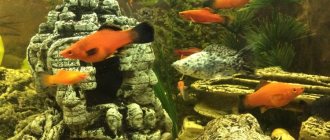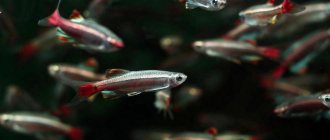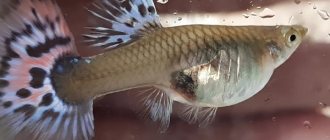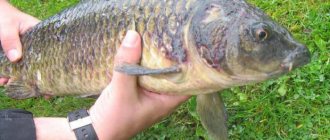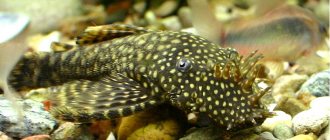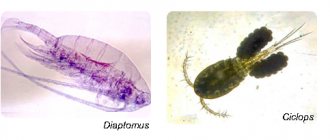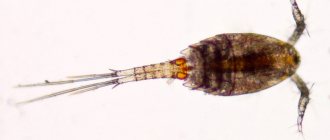Select the required aquarium size
Even if you are just starting your acquaintance with aquariums, you probably know that each type of fish has its own needs regarding space and their habitat. Some people will be comfortable in small aquariums (guppies, zebrafish, etc.). But a lot of free space is vital for a goldfish, otherwise it may die. Before purchasing an aquarium and its inhabitants, it is better to read in more detail about each species in advance.
A lack of free space leads to the following consequences:
- The fish refuse to eat and become very lethargic and inactive.
- Formation of rot on the fins.
- The color of the fish fades.
Toilet training
If the breeder has not toilet trained the babies, the new owner does this from the very first days. You need to prepare a tray with filling, diapers and newspapers. They are spread throughout the room. As soon as the puppy has emptied, his feces along with the bedding are transferred to the tray. Then you need to keep an eye on him and take him to the toilet every time as soon as he sits down to make a puddle or a pile. You cannot scold or shout if a mistake occurs. You should be patient and after a few days the result will be visible. To train the Chihuahua to use the toilet outdoors, take it for a walk every time after eating or sleeping.
Proper diet
The basis of keeping aquarium fish is their nutrition. Food can be of several types:
- Natural. Live, frozen or gelled food.
- Dry. Available in the form of granules or flakes. It is selected in accordance with the anatomical structure of the mouth of the aquarium inhabitants.
- Supplements They are used as additional support, maintaining color and improving appearance.
The most important recommendation is to never overfeed your fish! After purchasing a new aquarium, you need to start by feeding it no more than once a day. Gradually, the frequency increases, but measures are needed here too. Don't forget that an aquarium is a closed habitat. If you give a lot of food, it will not be eaten, but will sink to the bottom. As a result, an ideal environment for the proliferation of harmful microorganisms is formed. In addition, from overeating, fish become fatter and reproduce worse.
The optimal feeding frequency for fry is 4 times a day, for guppies and goldfish - 2 times (features of feeding other species can be found on the Internet). Once a week you can have a fasting day.
Parasitic diseases of Pomeranian Spitz, control and prevention
You can raise a healthy Pomeranian if you know your enemy by sight. The list of dog parasites is extensive and daunting. However, they can be divided into 3 large groups, which have differences in infection, control measures and prevention.
Are fleas harmless?
In the warm season, fleas are found almost everywhere in nature. These jumping insects easily move through space until they find a warm-blooded host. Parasitizing on its skin, they bite through it and receive nutrition from the animal’s blood. A full development cycle of 50 days and abundant egg laying makes the population of these insects very tenacious.
Fleas rarely carry dangerous diseases because they do not try to change their host. However, there is harm from them:
- bites cause irritation to the skin of the Pomeranian Spitz; with a large area of damage, secondary infection is possible;
- insemination of the intestines by larvae causes allergies and decreased immunity;
- contact with fleas bothers the dog.
It is possible and necessary to fight fleas. Daily combing of the coat and inspection of the skin of the Pomeranian Spitz is the first step towards detecting the enemy and partially destroying it mechanically.
Since fleas lay eggs in the environment, an important means of preventing infection is to keep the house clean and timely disinfection of objects to which the Spitz has access (simple washing is sufficient).
To prevent fleas from getting on the skin, use anti-flea drops applied to the skin of the withers. Special collars for Pomeranians are not recommended - if worn constantly, they damage the hair in the neck area and often cause allergies in dogs of artificially bred breeds.
Ticks - high danger level
Unlike fleas, ticks often carry viral diseases that are harmful to the body of warm-blooded animals.
Before sucking, the tick injects an anesthetic secretion into the soft tissues, so the bite occurs unnoticed by the orange, and at first it does not show concern. If the tick is not infected, it will drink blood and leave the skin on its own without causing much harm to the Pomeranian. But now more and more individuals are infected with viral diseases, which does not prevent them from migrating over long distances and expanding their habitat.
During the warm season, ticks can be found in all areas with vegetation. In extreme heat and significant cold weather, it is inactive; thickets of trees and tall grass in shady places pose a danger.
The orange's natural temporary protection is its thick coat. Ticks, unlike fleas, are slow-moving creatures. It takes a lot of time to get to the place of attachment (to an area with thin skin).
Hence the preventive measures: carefully inspect the Spitz’s coat immediately after a walk, remove any ticks that get on it.
If you are not allergic to anti-tick sprays, you can use them, especially for adult Pomeranians.
Helminths in Pomeranian Spitz
Worms are parasites that live inside the host's body, most often in the intestines. Some species also develop in other organs. They can cause serious diseases (the most harmless of which are anemia and allergies) and even the death of not only a puppy, but also an adult Pomeranian.
It is impossible to avoid infection with helminths, but it is possible to prevent infection and the development of larvae through prevention (deworming).
Puppies are already given antiparasitic measures in the nursery, usually from 2 weeks of age. And they repeat them regularly. When transferring to a new owner, the veterinary passport indicates the date of the last administration of anthelmintic drugs and recommends further frequency of prophylaxis.
A healthy, seasoned animal that receives proper care can cope with helminthic infestation more easily than weakened individuals.
Thus, good care, proper maintenance, and development of the Spitz’s immunity significantly increases its chances in the fight and prevention of parasitic diseases.
Temperature compliance
Depending on the inhabitants, the water in the aquarium can be cold or warm. Even a small difference of 4-5 degrees can lead to a worsening of their condition. The optimal temperature is +23-24 degrees Celsius (with the exception of angelfish, discus and black fish).
Accordingly, every aquarist should have a thermometer and special heating in order to bring the temperature to the required parameters if something happens.
You can understand that the temperature indicator is not normal by the following signs:
- The temperature is below the optimal level - the activity of the aquarium inhabitants decreases, they become extremely slow.
- The temperature is above the optimal level - the color becomes unnaturally bright, the fish swim to the surface and greedily swallow air.
Some important rules
Rules to follow:
- It is very useful to brush your Spitz's coat before bathing. This will allow you to achieve better washing results.
- The bottom of the bath is covered with a rubber or silicone mat to prevent paws from slipping and causing panic. The dog must stand steadily.
- It is advisable to carry out the first baths together: one owner holds and calms the dog, the second wets the fur and distributes shampoo, and receives the animal in a towel. This makes it possible to streamline the procedure and gradually teach the Pomeranian to tolerate it calmly.
- After wetting the wool, the detergent is applied from top to bottom, without circular soaping, gently massaging the coat. When choosing a shampoo, pay attention to the content of unnatural substances; preference is given to hypoallergenic formulations.
- The head is washed last, avoiding getting water into the ears and shampoo into the eyes. A damp atmosphere in the bathroom and without targeted washing will soften dried dirt in the ears and eyes; they can be easily removed with a cotton pad and pad.
- Do not wipe wet Spitz fur with a towel, but only blot it. You can change the towel and repeat the removal of moisture.
- It is not necessary to use a hairdryer in a warm, dry and clean room. Wool dries quickly naturally. If the temperature in the house is unstable, it is recommended to use a directed, non-hot and gentle stream of air (from bottom to top, from the stomach to the back).
Bathing softens dried dirt, eliminates odors, and unclogs skin pores. Pomeranians usually feel very good after a properly performed procedure.
Changing water
Caring for fish is closely related to caring for the aquarium itself. Many beginners begin to change the water prematurely, as soon as the water becomes slightly cloudy. The fact is that this is a closed ecosystem, so such haste leads to its destruction, therefore, you will have to “start” your aquarium again. Need I say that fish will not react in the best way to such stress?
A universal recommendation is to drain about a third of the water from the tank, adding fresh water to it, i.e. A complete water change cannot be carried out.
Historical reference
The first information about budgerigars appeared at the beginning of the 19th century. The origin of budgerigars dates back to Australia. In 1840, budgerigars were first brought to London Zoo. Soon the budgerigar appeared in France, Belgium and Germany. Thus began the mass capture and export of these birds from Australia. Cages containing hundreds of thousands of birds were transported by ship to Europe. Many birds died during transportation.
But after some time, information appeared about their successful breeding in captivity. Soon, budgerigars lived almost throughout Europe. Back then it was an expensive pleasure and only wealthy people could afford to purchase an exotic bird. By 1860, many zoos in Europe already had their own populations of these birds.
Due to the massive and unregulated trapping of parrots, there has been a sharp decline in the number of budgerigars. Due to the large-scale and cruel trade, in 1894 the Australian government passed a law banning the export of all species of birds living in the country. Now the number of budgerigars in captivity significantly exceeds the number of these exotic birds living in nature.
Parrots were brought to Russia from Europe. Soon they began to be bred at the Moscow Zoo, and later at home. The greatest interest in these birds has arisen because of their ability to imitate human speech. Now these birds are massively popular among caged birds.
Check your oxygen levels
Not a single aquarium fish can survive in conditions of oxygen deficiency. Therefore, you definitely need to buy an aerator, but its power should not be too high. A specialized store will advise you on a suitable model.
If there is algae in the tank, the aerator should be left on overnight. Many plants release carbon dioxide abundantly at night, so if there is not enough oxygen, your aquarium inhabitants will die.
What does a budgie look like?
The budgerigar looks small. The size of a budgerigar is from 17 to 20 cm in length, with a tail length of 8-10 cm and a wing length of about 10 cm. These birds weigh only 40-45 grams. The budgerigar looks very colorful due to its plumage, which is predominantly grass-green in color. The throat and front of the head are a rich yellow color.
Thanks to its long, stepped tail, the budgerigar appears to be larger than it actually is. The curved beak of these birds is covered with a horny layer; it is very mobile and powerful. At the base of the beak there is a cere, on which there are nasal openings. The upper jaw of the beak is much longer than the lower.
The budgerigar's beak is universal. The parrot uses it to pick small branches, leaves, seeds and various fruits. In addition, with its help, budgies can lift and carry various objects. The beak also helps parrots climb tree branches and even defend themselves. The inner side of the beak has teeth that clean the grains from the husks and help to pick and chew the fruits.
Budgerigar chicks have a dark beak; in adult birds it is pale yellow, with a greenish tint. The cere, located above the beak of birds, allows you to determine the sex of a budgerigar. Budgerigars are easily distinguished by the color of the wax. In a young male it is purple, in an adult it is bright blue. In a young female it is blue, in an adult it is blue or brown.
The strong and prehensile feet of this parrot are grayish blue or light pink in color and have black, dark blue or white claws. These birds have 4 sharp and curved toes on each paw. Two of them are directed forward and two are directed backward. This allows parrots to very dexterously climb branches, walk on the ground and grab something with their paws.
One of the unique properties of what a budgerigar looks like is fluorescence (the ability to glow). The feathers of a budgerigar fluoresce when exposed to sunlight. In nature, the presence of fluorescence plays an important role in the reproduction of budgerigars.
Correct lighting
Fish in an aquarium require a sufficient amount of light, which affects their well-being, activity and survival of their offspring. Please note that natural light will not be enough, so you need to take care of purchasing special equipment. There are lamps that not only illuminate, but also disinfect water with ultraviolet radiation.
Feeding a puppy from birth to 1 year
From birth to three weeks, Chihuahua puppies are breastfed. If for some reason they are deprived of this opportunity, they are fed every two hours with special milk formulas, which can be bought at the pharmacy. In the fourth week, the first complementary foods are given - a mixture of goat's milk and eggs, then liquid oatmeal, buckwheat or rice porridge, and cottage cheese. In the second month, turkey or rabbit meat is introduced into the diet.
At the age of two months, Chihuahuas are completely transferred to independent feeding and are given food 5-6 times. At four months, milk is replaced with protein foods, offal is introduced into the menu, and the total daily portion is increased.
From six to nine months, the number of meals is reduced to three times. The diet should consist of 50% meat, 25% vegetables and 25% cereals.
From nine months to a year, the Chihuahua's diet is switched to a two-time diet, with caloric content adjusted according to individual characteristics (60 kcal per kg of weight).
Choose the right fish for your aquarium
The choice of fish for novice aquarists should be conscious. It should not be based solely on their appearance. For beginners, it is better to choose unpretentious individuals that do not require serious personal care. If you buy too expensive and whimsical fish, then there is a high probability that your first experience will be unsuccessful, because in the first couple it is difficult to avoid mistakes. It would be a good idea to ask the seller about the specifics of caring for a particular type of fish.
There is an important rule - all aquarium fish that you plan to keep in a closed ecosystem must have the same requirements for feeding and water quality. It is advisable to select individuals of approximately the same size and temperament.
When purchasing, it is important to inspect the fish. Any damage, wounds, or problems with scales are a sure sign that you don’t need to buy them. It is better to take non-mature individuals, which are better adapted to changes in habitat.
Chihuahua in the house: where to start
Before picking up a puppy from the breeder, you should carefully prepare - carry out a general cleaning, remove small objects that he can reach, hide electrical wires, and close dangerous holes and cracks. A place for your pet will be organized in a cozy corner, where he can retire and relax on a soft mattress. The lounger should have removable covers to keep the bedding clean. For the Chihuahua, prepare dishes and a stand for it, a litter tray, toys, means and tools for maintaining hygiene, a carrier, a leash, a collar and overalls. There should be a first aid kit in the house.
The puppy is taken home in the morning so that before nightfall he has time to look around and get used to the new place a little. Immediately, the baby begins to be accustomed to a nickname and a toilet, based on how this happened with the breeder.
Basics of caring for fish in an aquarium
Caring for aquarium inhabitants should be thorough and regular. This includes the correct feeding regimen, cleanliness, and a sufficient level of lighting.
Here are the basic instructions on how to care for fish in an aquarium:
- Don't forget to change the water. First you need to settle it - pour the required amount into the tank and leave it for 2-4 days. Only after this can you add it to the aquarium. In this case, you need to maintain the level of new water: in a 100-liter tank, only 30% of new water is added (for a 200-liter aquarium this figure is less - only 20%). Settled water must be brought to the required parameters using chemical reagents.
- Regularly clean the bottom of food residues using a siphon.
- Do not turn off the heating unless absolutely necessary.
- Monitor their appearance every day. Any deviation from the norm (wounds, dull color, decreased activity) is a reason to isolate the fish (it is placed in a separate tank).
- You definitely need a scraper to clean aquarium glass from dirt and algae. The driftwood is cleaned with a regular brush (once every 2 weeks).
engaged in the production and comprehensive maintenance of aquariums. Installation of filtration systems, scheduled water changes, cleaning, and treatment of fish are just a small part of the activities that this service includes. To keep your pets always healthy and pleasing to your eyes, follow the tips we talked about today. For our part, we will provide you with all possible assistance, taking care of all the care - all you have to do is feed your fish.
Soil siphon
During the life of the aquarium, a large amount of organic substances also accumulate in the soil - fish waste, food residues, dead particles of living plants, etc. Accumulating in large quantities, they cause an increase in nitrates and phosphates - the main food of algae.
Therefore, regular cleaning of the soil is very important in caring for the aquarium. For this purpose, a special device is used - a soil purifier, or siphon. Using it, it is easy to clean the soil from major contaminants and at the same time change the water, which allows you to reduce high concentrations of nitrates.
Possible diseases
For a number of reasons, your pet chinchilla can get sick. In such cases, the pet will require immediate medical attention. An experienced specialist will conduct a diagnosis and select a treatment course based on special medications intended for rodents.
What diseases can a chinchilla develop:
- Hyperthermia is overheating of the body. This condition occurs if the recommended temperature regime is not observed. The deterioration of the pet’s condition begins already at an ambient temperature of +250C. If the air warms up to 300C, the chinchilla may die suddenly. The main symptoms of hyperthermia: immobility, redness of the tongue, stretching of the body while lying on its side, convulsions. First aid: the cage with the chinchilla needs to be moved to a cool place. To relieve her condition, it is recommended to moisten the outside of her ears and paw pads with cool water. To prevent dehydration, give your chinchilla water to drink.
- Abnormal stools and liquid feces are a fairly common problem in domestic chinchillas that arise as a result of poor quality nutrition or after a change in food. The owner needs to disinfect the cage and review the chinchilla’s diet. To combat loose stools, special medications are used that can be purchased at a veterinary pharmacy.
- Colds - occur due to hypothermia of the animal. For example, if the cage is in a draft or the chinchilla has been in low temperatures for a long time. Main symptoms: runny nose, cough, sneezing, watery eyes, lethargy. Chinchilla colds can be treated with medications prescribed by a veterinarian.
- Ringworm is manifested by hair loss in a certain area of the body. It develops as a result of stress or fear, as well as due to low immunity, unsanitary living conditions, or after contact with an infected pet. It is treated with special ointments as prescribed by a doctor.
In addition to the listed pathologies, the domestic chinchilla can develop diseases of the eyes, ears, digestive organs, reproductive system, and even have a stroke. Proper care and quality nutrition will reduce the risk of developing diseases.
What things do you need to have to care for your budgie at home?
For favorable mental and physical development of the bird, it is necessary to create comfortable living conditions for it in the house. Nothing should threaten the health of your feathered friend.
You need to prepare a place for a cage for a new pet to live in advance, before you bring it home. To avoid possible injuries when the parrot walks around the room, remove all objects that may be in any way dangerous to its health: chemicals, various crayons, markers, breakable and small things, wires.
To carry out proper care and maintenance of budgies at home, it is imperative to buy cages . They must be comfortable and properly equipped. Namely, include a drinking bowl, feeder, bath, perches and toys. When purchasing, pay special attention to the shape of the bird's home. I advise you to buy large copies, rectangular in shape. Since in nature these birds often fly from branch to branch, in order to feel comfortable they need a lot of space.
Bird housing must be located in a place suitable for the favorable mental and physical state of the bird. Therefore, think first of all not about the aesthetic beauty of the room, but about the comfort of the parrot.
Classification
According to I. Fisher's classification system, all budgerigars are divided into two groups.
The first group includes birds of any color with normal waviness, including four subgroups:
- Green with black wave pattern
- Blue with black wave pattern
- Yellow with a faint bluish wavy pattern
- White with a faint bluish wavy pattern
In these subgroups, 3 main tones of plumage are distinguished: light color, medium color, dark.
The second group includes parrots of variegated colors that have not retained the wavy pattern:
- Albinos
- Lutinos
- With opaline pattern
- With brown pattern
- Motleys
- Harlequins
- Lacewings
- Versatile
Crested budgies are placed in a separate group.
